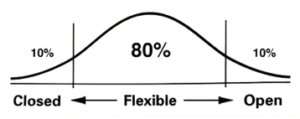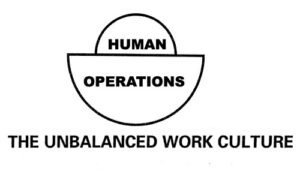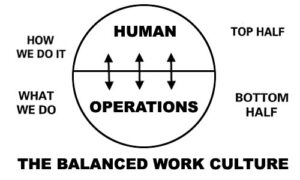1. What Is Company Culture?
Your company’s culture is its personality, the unique way your company sees the world and acts. Just as our personality guides what we do, an organization’s culture affects everything employees do — how energetically they contribute to teamwork, problem-solving, innovation, customer service, productivity, quality, and profits.
A company’s culture makes it safe — or not safe — for a person, division, or the whole company, to take responsibility, raise issues and solve problems, act on new opportunities, manage change, and move in new, creative directions. When prospective employees search for information on your company, they want to know what it feels like to work there. Would they enjoy it, or is it like most companies, rather ho-hum — or worse?
The right company culture is good for people and good for business.
2. The Human and Operations Halves of Culture
Company cultures have two parts, operations and human. In most companies, these are out of balance. That’s bad for people and bad for performance. Developing your company’s culture means getting these two halves in balance.
Fortunately, rebalancing the work culture is straightforward. You have almost complete control over how you do what you do, and the human or people side is about how things are done. Your people will eagerly support you in building a more satisfying, engaging workplace.
Guiding you on that path is the business of this website.
3. Demonstrate Values Through Leadership
What we do depends on who we are (our personality), and our situation (where we are).
 In a college class, we sit quietly, at a ballgame we jump and shout. We are the same person but our situation changed. Most people behave appropriately to the situation — as they see it.
In a college class, we sit quietly, at a ballgame we jump and shout. We are the same person but our situation changed. Most people behave appropriately to the situation — as they see it.
At work, leaders can’t manage people’s personalities — and probably shouldn’t try — but they have almost complete control of the situation, the work culture. It’s the work culture that tells everyone what’s expected and how to do their work.
The Flexible Middle
Most of us are flexible. As new employees, we accept and adapt to the organization’s culture. If the work culture is friendly, we will be friendly. If the work culture is critical, we will be critical.
 Take one cultural quality, “openness”: openness to others, openness to change, openness to bringing more of yourself to the task, and so on. People vary widely in their capacities, some are mostly open, some mostly closed. The big opportunity for culture change is the flexible 80% in the middle who will be open if the culture encourages that and be closed if the culture encourages that. This is true of any cultural quality, such as trust, cooperation, engagement, and so on..
Take one cultural quality, “openness”: openness to others, openness to change, openness to bringing more of yourself to the task, and so on. People vary widely in their capacities, some are mostly open, some mostly closed. The big opportunity for culture change is the flexible 80% in the middle who will be open if the culture encourages that and be closed if the culture encourages that. This is true of any cultural quality, such as trust, cooperation, engagement, and so on..
Leaders Get What They Show
Most people want to be engaged at work. They will be engaged if they see leaders are open to ideas and involve employees in discussions and decisions. Whatever qualities leaders show will be reflected back. That’s why you can change the culture. Just show the qualities and values you want to encourage.
Example
This regional management team of an international shipping company met for an hour every three weeks to discuss the human side of their multi-state operation. After 12 meetings they were quite sophisticated. They understood that people-related issues in their 20,000-person region reflected what they did as leaders.
At this meeting, one manager raised the lack of cooperation between districts in the region. I knew that they knew that the lack of cooperation reflected their own behavior, but I couldn’t resist asking, “In the last six months has anyone here made a negative comment about anyone else in the room or about another division?” One of the managers joked, “You mean since our coffee break this morning, right?”
The group laughed and soon moved on to other issues. When I returned three weeks later, I asked about the cooperation problem. A manager said the problem was gone. He said after I left, the group agreed they’d stop making negative comments about each other or about other divisions. They told their individual management teams about this agreement and asked them to do the same. In addition, they decided that when any of them went on a field visit, which they did often, they would always go together with at least one of the other managers from the regional team.
They said that the cooperation problem disappeared in three days. It was the fastest culture change I’d ever seen.


